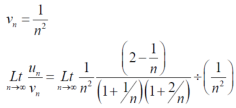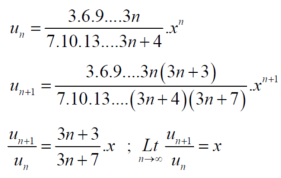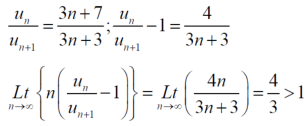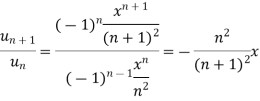 is convergent or divergent. A1)
is convergent or divergent. A1)The general formula can be written as,
We get on applying limits,
This is the convergent series and its value is 3 / 4 |
|
Here,
And
Hence the series is convergent and the limit is 1/2. |
|
We have First we will find
And
Here, we can see that, the limit is finite and not zero, Therefore, Since So that , we can say that,
|
|
Suppose,
Which is finite and not zero. By comparison test But,
Is convergent. So that |
 A5)
A5)We have
By D’Alembert ratio test,
So that by D’Alembert ratio test , the series will be convergent. |
|
We have,
Now , by D’Almbert ratio test At x = 1 , this test fails. Now , when x = 1
The limit is finite and not zero. Then by comparison test, Since Hence Therefore in the given series |
|
As we will neglect the first term, we get
By ration test The rario test fails, then
By Rabee’s test |
|
Here, we have,
Therefore the given series is convergent. |
|
Here Now apply integral test,
Let,
X = 1 , t = 5 and x = ∞ , t = ∞, Now,
So by integral test, The series is divergent. |
|
Here the given series is alternately negative and positive , which is also a geometric infinite series. 1. suppose, S = According to the conditions of geometric series, Here , a = 5 , and common ratio (r) = -2/3 Thus, we know that,
So , Sum of the series is finite , which is 3. So we can say that the given series is convergent. Now. Again sum of the positive terms,
The series is geometric, then A = 5 and r = 2/3 , then Sum of the series,
Sum of the series is finite then the series is convergent. Both conditions are satisfied , then the given series is absolutely convergent. |
 converges, then find the value of x.A11)
converges, then find the value of x.A11)Here Then,
By D’Almbert’s ratio test the series is convergent for |x|<1 and divergent if |x|>1. So at x = 1 The series becomes- At x = -1
This is an alternately convergent series. This is also convergent series, p = 2 Here, the interval of convergence is |
 , correct to five decimal places by using the power series for
, correct to five decimal places by using the power series for  .A12)
.A12)As we know that the exponential series is-
Here we get-
Now
|















































































